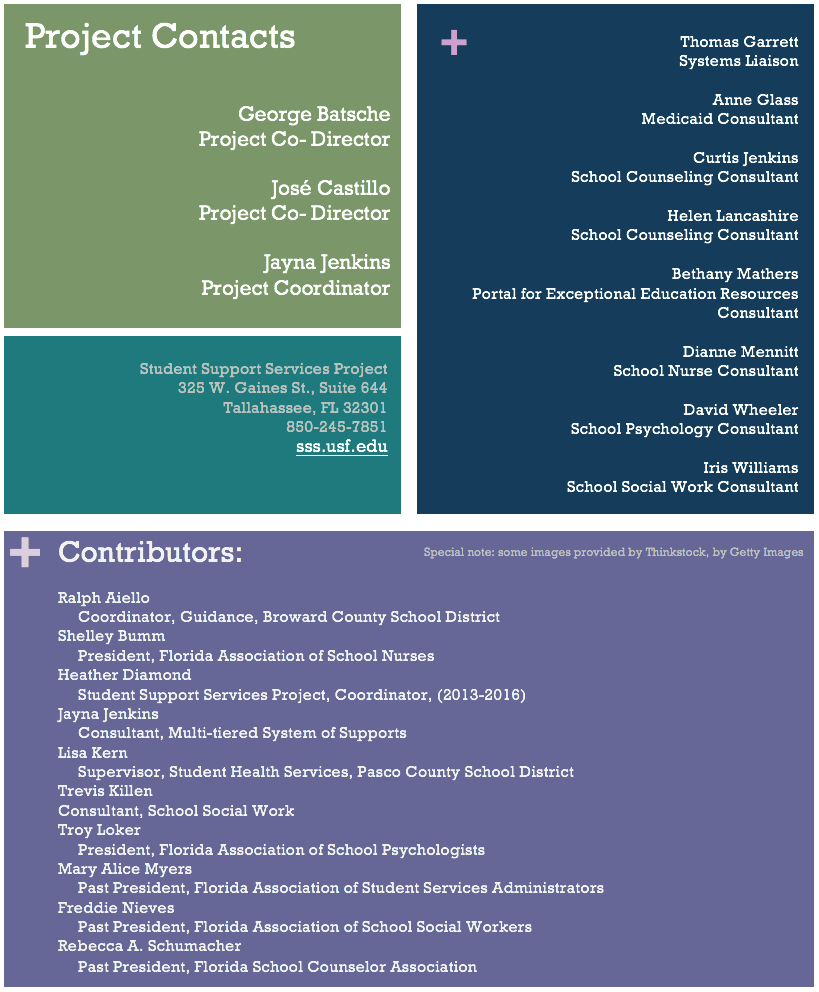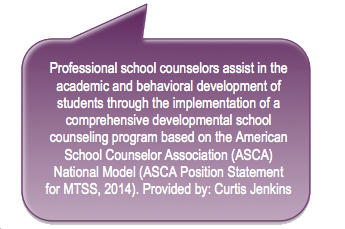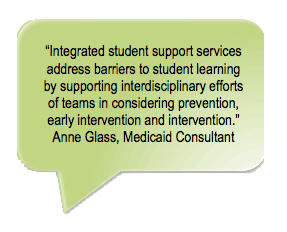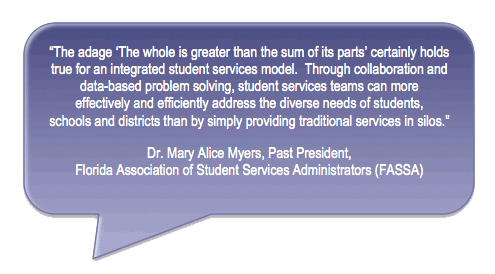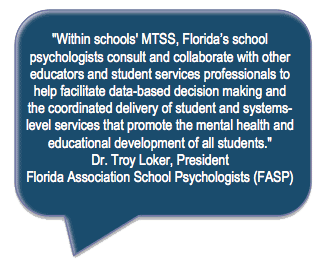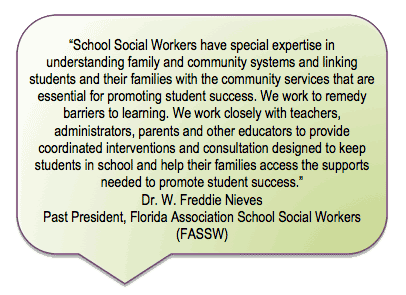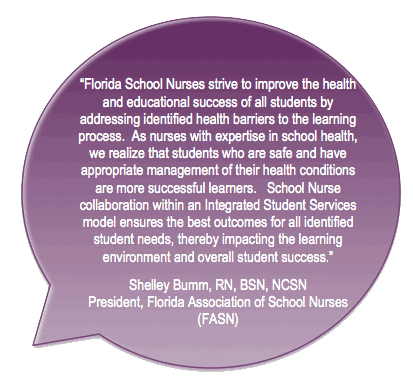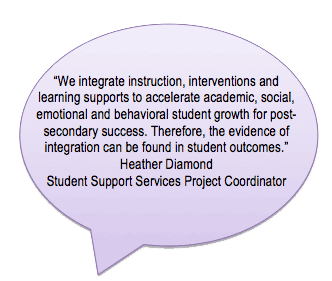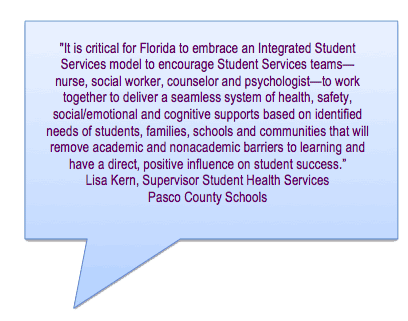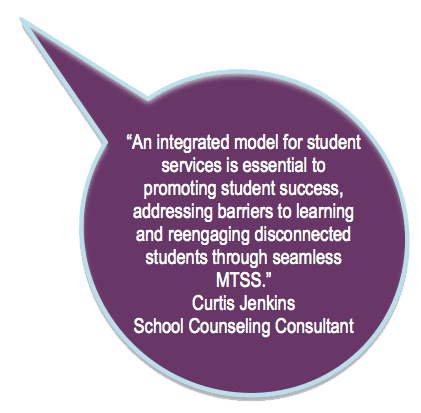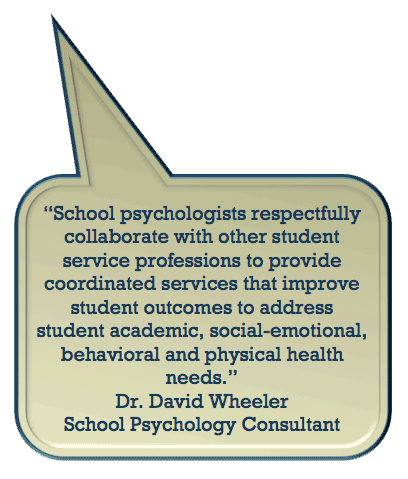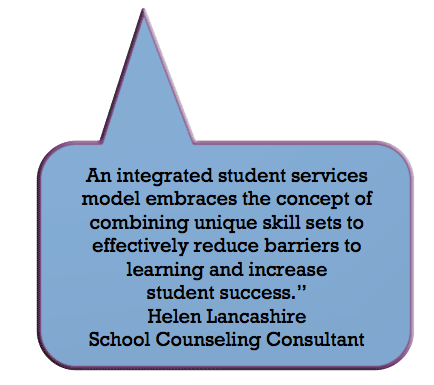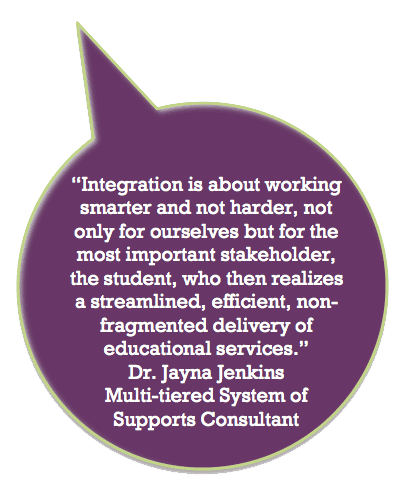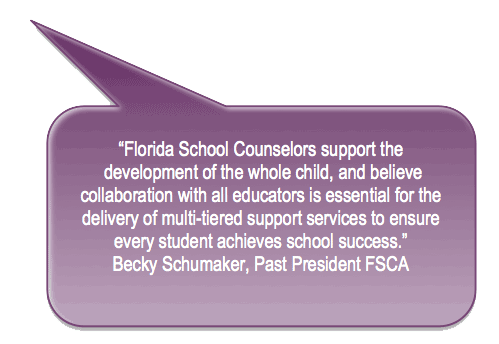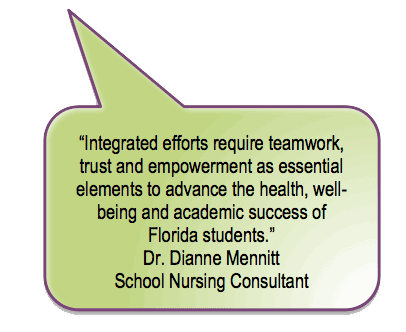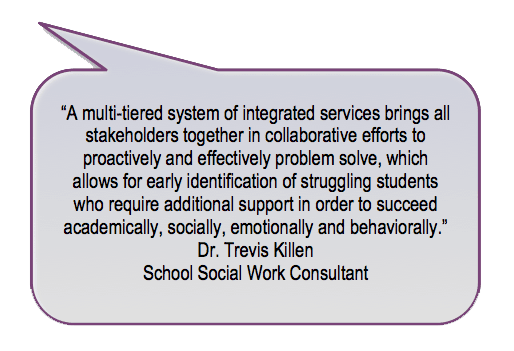
Integrated Student Services in Schools: Action Guide
- Did you know...
- All Florida school districts and schools are working toward full implementation of a multi-tiered system of supports (MTSS) to ensure efficient allocation of resources based on student needs and effective academic and behavioral instruction and interventions? Want more? Click here. Also see, Guiding Tools for Instructional Problem Solving (GTIPS)
- Take action...
The role of student services professionals must align with and support Florida’s State Board of Education Approved K-20 Strategic Plan vision, “Florida will have an efficient world-class education system that engages and prepares all students to be globally competitive for college and careers.” More specifically, in relation to the role of student services, Goal 1, Highest Student Achievement for K-12 Students, includes increasing the percentage of students performing at grade level, increasing student participation and performance in accelerated course options and increasing high school graduation rates. The strategic plan and related resources are available at http://www.fldoe.org/strategic_plan/. Student engagement, supported by integrated student services, is necessary for all students to meet Florida’s strategic goals and the increased rigor of standards.
Furthermore, today’s educational landscape is rapidly changing in ways that must be reflected in how student services professionals function and evolve. The students, families and schools in Florida are increasingly diverse in their need for support. With more complex needs related to contemporary issues (e.g., cyberbullying, life-threatening food allergies, child abuse and neglect, anxiety and depression, school violence and rigorous academic standards) comes the necessity to find more efficient and effective ways to meet the needs of students and families.
As members of school-based teams, school social workers, school psychologists, school counselors and school nurses working with their service partners are uniquely trained to provide support within the school community. They ensure that students are engaged learners progressing toward college and career readiness. District- and school-based teams that function within a multi-tiered system to provide a continuum of integrated services are best able to maximize the positive impact of learning supports on student outcomes. The MTSS is directed and organized by a structured data-based planning and problem-solving process. They also collaborate with behavioral, health, counseling and social service partners in agencies and community organizations beyond the school to extend the impact of school-based services. With commitment to professional development and continuous improvement, student services is a support system that enables the highest student achievement for all students.
 For whom is this guide intended?
For whom is this guide intended?
This guide was developed primarily for district student services leaders, itinerant and school-based student services professionals (school counselors, school social workers, school nurses, school psychologists) and secondarily for their partners (e.g., superintendents, district administrators, school administrators, principals, teachers, specialists, other agencies) who share the responsibility for effectively planning, providing and facilitating learning supports for students and their families.
What is its purpose?
The purpose of this Action Guide is threefold.
-
To communicate that learning supports provided by student services professionals are essential for social, emotional, behavioral, mental and physical well-being and highest student achievement;
-
To prompt professionals to build a consensus for coordinating (planning) and integrating the delivery of learning supports within the multi-tiered system to maximize impact on student achievement at both the district and school levels; and
-
To provide a foundation for state, district and school policy and practice to coordinate and integrate the delivery of learning supports provided by student services professionals.
 This guide is organized around the following questions to prompt reflection, facilitate professional dialogue and initiate action toward continual improvement:
This guide is organized around the following questions to prompt reflection, facilitate professional dialogue and initiate action toward continual improvement:
-
What is an integrated student services approach?
-
How are the student services disciplines related and unique?
-
What are learning supports?
-
Who provides learning supports?
-
Why must learning supports be integrated?
-
What do integrated learning supports look like?
-
How does district leadership effectively facilitate learning supports?
-
What next steps are needed?
As part of MTSS, integrating student services is an efficient and effective way to deliver learning supports at the schoolwide, student subgroup and individual student levels. This approach can be used by district and school student services leaders, within the context of the district’s MTSS implementation, to integrate the work of student services professionals, thereby maximizing the positive impact of learning supports for students and families.
MTSS consists of three tiers representing levels of academic and behavioral instruction and interventions (tier 1–universal, tier 2–supplemental, tier 3–intensive) based on evidence of student need. In a fully implemented multi-tiered system, all students receive universal supports and most students are successful as a result of the effective universal supports provided in core instruction. Examples of universal supports include
positive behavior supports, classwide family engagement activities and positive attendance reinforcers.
Some students require supplemental support in addition to universal supports, and few students require intensive supports in addition to and aligned with universal supports. Level of need is determined by measuring the impact of instruction, interventions and learning supports through ongoing progress monitoring in the targeted area(s). Examples of supplemental supports include small group counseling for specific focus areas, social skills training targeting an identified area of need and coordinating mentorships for at-risk students.
Integrating student services professionals involves adding learning supports provided by student services professionals to MTSS. Not only do teams engage in the planning and problem-solving cycle to make data-based decisions about integrated academic and behavioral instruction and interventions, but teams also include student services professionals and apply the process so that learning supports are integrated and matched to student needs. Examples of intensive supports include individualized diagnostic assessments, diabetes management supports and trauma-informed mental health counseling.
Figure 1 illustrates the three tiers of
learning supports in a fully implemented 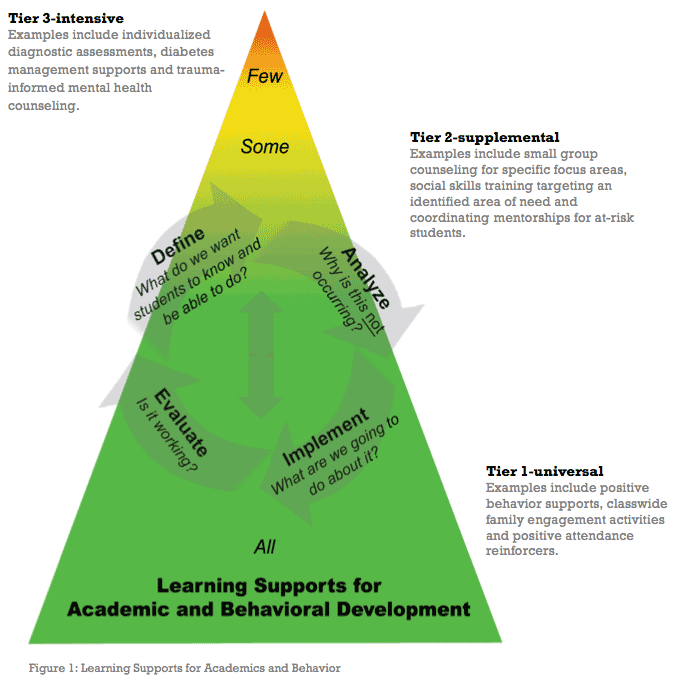 system.
system.
The tiers represent descriptors of the intensity level needed at many points along a continuum. Decisions about when and how to increase or decrease the intensity level of supports for students are made using the problem solving cycle also depicted in Figure 1.
Each of the four student services professional disciplines shares common areas of focus and common goals for all students and their families. Examples of common areas on which student services professionals focus their work are
|
|
|
|
|
|
|
|
|
|
|
|
|

When student services are integrated, each discipline’s unique contributions remain essential and must be coordinated (planned) in order to maximize the effectiveness of those services to all students.
Each of the four student services professional disciplines contributes unique skills, knowledge, experience and perspective to the collective work. For example, school social workers are typically most experienced with the family and community connection, school counselors have expertise of student progression requirements, school nurses typically have the expertise to manage the needs of students with chronic health conditions and school psychologists have expertise in assessment and data analysis.
Learning supports are the resources, strategies and practices that enable all students to be engaged learners. Learning supports are designed to enable learning by decreasing the challenges that interfere with students engaging effectively with instruction.
Examples of learning supports include, but are certainly not limited to, class or schoolwide prevention programs, early warning system leadership, data-based meeting facilitation, evaluation, food allergy awareness efforts, small-group counseling sessions, intervention progress monitoring, home visits, health screenings, individual academic advisement, individual healthcare plans and emergency care plans.
Learning supports are implemented at the schoolwide (tier 1–universal), student subgroup (tier 2–supplemental) and individual student (tier 3–intensive) levels to ensure efficient allocation of resources and maximize effectiveness via integration with academic and behavioral instruction and interventions (see examples in Figure 1: Learning Supports for Academics and Behavior). Data-based planning and problem solving is used to evaluate the impact of learning supports on students’ well-being and academic growth, which allows teams to determine the effectiveness of learning supports so that continuous improvement occurs.
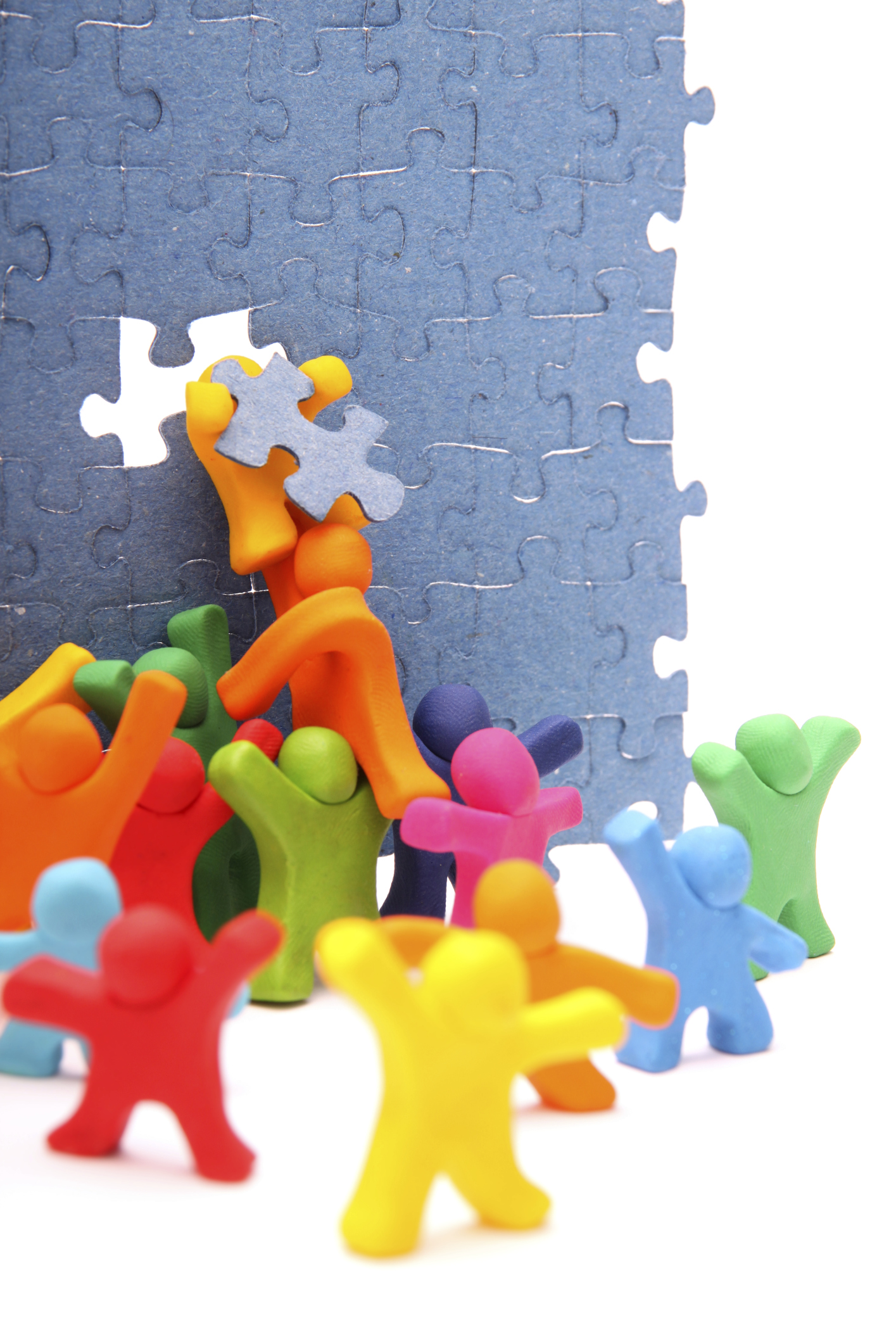
Within an MTSS, school counselors, school nurses, school social workers and school psychologists are primary providers of learning supports. Student services professionals provide learning supports in a variety of ways such as direct service, data analysis, planning, supporting and monitoring implementation fidelity, progress monitoring, facilitating and coordinating resources. Other educators (teachers, special education personnel, administrators, behavior specialists and others as needed) are also members of teams that engage in data-based planning and problem solving to improve academic, behavioral and social-emotional health and student engagement factors so that all students are able to obtain college and career readiness.
- Did you know...
- Students face multiple challenges related to family stressors, poverty, bullying, health problems and many other factors that play a part in our students’ everyday lives? For example, national research indicates that approximately 20 percent of youth have diagnosable mental health conditions (Merikangas et al., 2010).
- There are nearly 2.7 million public school students in Florida. Given a prevalence rate of 20 percent, we would expect over 500,000 children and adolescents in Florida have mental health needs; 10 percent of them with a serious mental health disorder causing significant functional impairment. Want more? Click here.
- Take action...
Effective instruction is necessary, but not sufficient, when students are experiencing challenges that inhibit learning and engagement. Teams that include student services professionals across disciplines are better able to coordinate learning supports and use student-centered data to plan, implement and continually improve the efficiency and effectiveness of the multi-tiered system. The teams regularly use data to inform improvements related to the interaction of the student with the instruction/interventions, curriculum and environment. As a result, students benefit from comprehensive, rather than fragmented, supports for their academic and social-emotional progress. We know that integrating the academic and behavioral supports for students is more effective than treating these areas separately. Also, a benefit of coordinating and integrating learning supports is that teams are able to determine both gaps and duplications in services and adjust in order to allocate resources more efficiently. By integrating learning supports, the full range of student needs for safety, health, academic support and well-being are addressed so that they are able to access effective instruction leading to college and career readiness.
Developing a clear and consistent vision of what integrated learning supports look like requires local, team-based collaboration among student services professionals that include the expertise of district and school leaders in school counseling, school nursing, school psychology and school social work. The vision developed by student services teams at the district and school levels using student-centered data must reflect and align with the characteristics and needs of each district and school. The content of this Action Guide reflects the vision of student services leaders at the state level, including each discipline’s professional organization. The voices highlighted here represent the unique perspectives of various statewide leaders in student services and are meant to convey the collective vision for what integrated learning supports look like.
| A multi-tiered system... | ...to advance the health, well-being and academic success |
| ...Florida School Counselors support... | ...working smarter and not harder |
| ...reengaging disconnected students | combining unique skill sets to... |
| School psychologists respectfully collaborate with... |
It is critical for Florida... |
| We [school social workers] work to remedy barriers to learning. | ...student growth for post-secondary success. |
| ...help facilitate data-based decision making | Florida school nurses strive... |
| address the diverse needs of students... | ...by supporting interdisciplinary efforts of teams |
| Professional school counselors assist in... |
Special note: View PDF version if you experience difficulty viewing the quotes.
 MTSS provides the framework for organizing and delivering the supports that will ensure student success by using data to plan for simultaneously engaging students in learning and removing barriers to learning. It is important to recognize that students have varying needs and that correspondingly varying levels of learning supports will be necessary for all students to access and attain standards. District leadership can help by establishing policies, infrastructure (e.g., personnel, schedules) and opportunities for shared learning experiences through cross-disciplinary team professional development and professional learning communities to ensure that school-based professionals, especially principals, are equipped to integrate student services within an effective MTSS.
MTSS provides the framework for organizing and delivering the supports that will ensure student success by using data to plan for simultaneously engaging students in learning and removing barriers to learning. It is important to recognize that students have varying needs and that correspondingly varying levels of learning supports will be necessary for all students to access and attain standards. District leadership can help by establishing policies, infrastructure (e.g., personnel, schedules) and opportunities for shared learning experiences through cross-disciplinary team professional development and professional learning communities to ensure that school-based professionals, especially principals, are equipped to integrate student services within an effective MTSS.
Examples include:
-
Learning-centered attendance policies
-
Schedules that allow for team data days, where student services participation is prioritized by principals
-
Job-embedded professional development that requires cross-disciplinary team participation
Additionally, there are three specific ways, detailed on the following pages, that professionals at the district leadership level can work to facilitate the provision of learning supports and ensure student success:
7.1 by fostering student engagement,
7.2 by engaging in data-based planning and problem solving and
7.3 by promoting a multi-tiered system of supports.
Student engagement is necessary for students to reach their learning goals. Student engagement represents the amount of time and effort students spend on educationally purposeful activities and is facilitated by how the districts and schools allocate resources and organize the curriculum and other learning opportunities to get students to participate in activities that are linked to increased student learning.
With effective district leadership and support, student services professionals contribute both directly and indirectly to all dimensions of engagement by serving on teams such as those conducting lesson study, to plan and implement continuous academic and behavioral improvement efforts such as positive behavior supports, working directly with students to remove barriers to learning such as inability to access instruction without accommodations.
The supports provided by student services professionals are critical to increasing student engagement and positive student outcomes. Some of the critical functions student services professionals perform to support engagement include the following:
Providing a continuum of support services that focuses on prevention and intervention for academic, behavioral, mental and physical health needs and is responsive to the diverse and developmental needs of all students.
-
Working with teachers and administrators to develop a positive school climate, effective behavior management and positive social-emotional well-being.
-
Facilitating collaborative, data-based problem solving as members of school-based teams, with essential skills in data collection and analysis, problem solving/hypothesis development, intervention planning, design, implementation and group processes in order to more effectively engage students.
-
Conducting initial (screening, baseline), formative (progress monitoring, diagnostic) and summative assessments in both academic and behavioral domains that support effective teaching and learning so that data are used to plan instruction that engages students.
-
Fostering collaboration among school teams that include parents, general and special education professionals, administrators and community representatives.
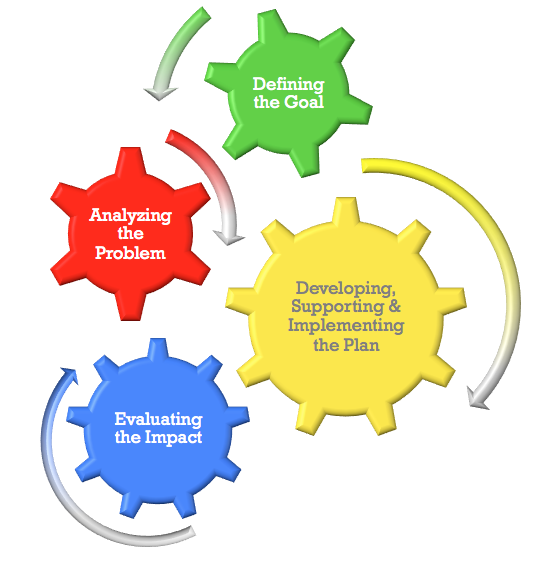 In order to make informed decisions to implement an effective MTSS, the use of a structured, data-based problem solving cycle is critical to ensure that each of the tiers is constructed in response to the specific needs of the district, school and student population. This team-based process requires engagement in a continuous improvement cycle that includes:
In order to make informed decisions to implement an effective MTSS, the use of a structured, data-based problem solving cycle is critical to ensure that each of the tiers is constructed in response to the specific needs of the district, school and student population. This team-based process requires engagement in a continuous improvement cycle that includes:
-
defining the goal to accurately identify the current situation compared to the desired outcomes;
-
analyzing the problem to generate and validate hypotheses about why there is a gap between the current situation and the desired outcomes;
-
developing, supporting and implementing learning supports matched to needs identified by data analysis; and
-
evaluating the impact by using the student-centered response to intervention data to evaluate progress toward the desired outcomes demonstrated by their response to the learning supports provided.
These data are used for making decisions to sustain, adjust or change the multi-tiered system and the specific learning supports based on evaluation of implementation fidelity and student outcomes.
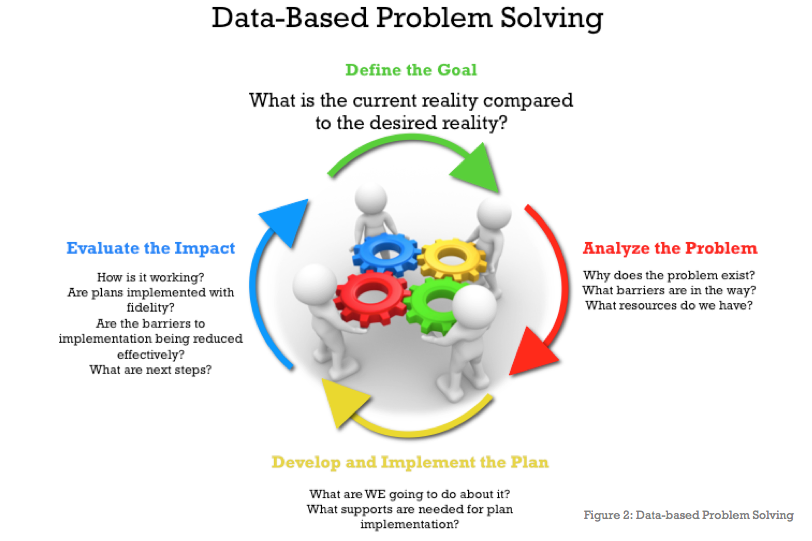
Figure 2 illustrates the cyclical, ongoing nature of data-based planning and problem solving. Using data to make systemic decisions, as well as decisions about delivery of supports to students, is essential to implementing and sustaining an effective multi-tiered system that allocates resources efficiently to meet the needs of all schools and students. The essential questions of the 8-Step Planning Process that is used in the Florida Department of Education (FDOE) Continuous Improvement Management System for development of the District Improvement and Assistance Plan and the School Improvement Plan are also conveyed in Figure 2. Data-based planning and problem solving at the organizational or “systems” level is the primary way that district and school leadership teams use data to improve outcomes by implementing a more efficient and effective MTSS as illustrated in Figure 1.
Integrating Tiered Learning Supports Through Problem Solving is a tool that can be used by district- and school-based teams to ensure they are engaging in data-based planning and problem solving effectively when integrating learning supports throughout the three tiers of the multi-tiered system.
The FDOE promotes and supports the implementation of MTSS. Decisions to improve student engagement, level of performance and rate of progress are based on student response data. MTSS is an evidence-based delivery model that focuses on prevention and early identification and allocates learning support resources on a continuum of support based on student need. This “need-driven” decision making seeks to ensure that district resources reach the appropriate students (schools) at the appropriate levels to accelerate the performance of ALL students to achieve and, when possible, exceed proficiency.
Considering the demands of engaging all students, district teams may benefit from self-reflection to strengthen their skills used for data-based planning and problem solving and promoting an MTSS. District leaders and teams can conduct a self-directed needs assessment and use the resulting data to plan improvements in leadership skills and behaviors that impact student achievement.
The District Leadership Needs Assessment is a tool that has content adapted from research and aligns with the components of Florida’s MTSS.
To ensure that student services professionals are included in each school’s MTSS, state and district policies, infrastructure (personnel and schedules) and practices must be aligned and coordinated by state, district and school leaders. The next step for integrating student services is to establish a common understanding for open discussions among district and school leaders, teachers, parents, students, community partners and student services professionals. Use this Action Guide to begin these conversations. Student services district leaders can also facilitate implementation-planning efforts.
Take action...
The following action steps can guide this facilitation:
-
Engage students, parents, school staff and community partners to assess, plan and implement a comprehensive, integrated student services model.
-
Conduct a needs assessment to determine current resources and infrastructure that supports integration efforts.
-
Identify shared priorities among student services professionals and their partners at the local level and analyze existing data relevant to the shared priorities to verify levels of systemic need.
-
Participate on cross-disciplinary teams to identify and reduce barriers to learning by planning and implementing evidence-based universal, supplemental and intensive supports as illustrated in Figure 1.
-
Assess multiple sources of qualitative and quantitative data in collaboration with school and district staff to identify student needs in academic, behavioral, social, emotional, physical and mental domains.
-
Ensure the coordination of learning supports provided by each of the four disciplines of student services for integration with academic and behavioral instruction and interventions to be delivered to students within the multi-tiered system.
-
Monitor student progress at the districtwide, schoolwide, subgroup and individual levels and participate in cross-disciplinary team discussions related to the needs of students and the capacity of student services professionals providing multi-tiered learning supports.
The four disciplines of student services (school psychologists, school nurses, school social workers and school counselors) each bring essential expertise to the field of education. They also share a responsibility to enable students to learn, achieve their potential, graduate from high school and successfully pursue post-secondary options for a productive and fulfilling adulthood. Student services professionals, across disciplines, promote safe and healthy school environments and support social, emotional, behavioral, academic, physical and mental wellness so that students are engaged and successful learners.
The learning supports provided by student services professionals reduce a wide array of barriers to learning that arise across the student population. Teams of student services professionals coordinating learning supports in collaboration with each other, parents, community representatives and other educators using data-based planning and problem solving are best able to provide integrated supports to increase student engagement for highest student achievement.

